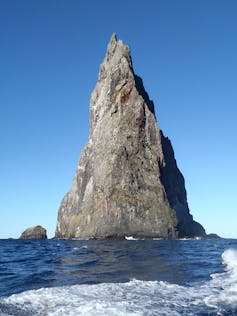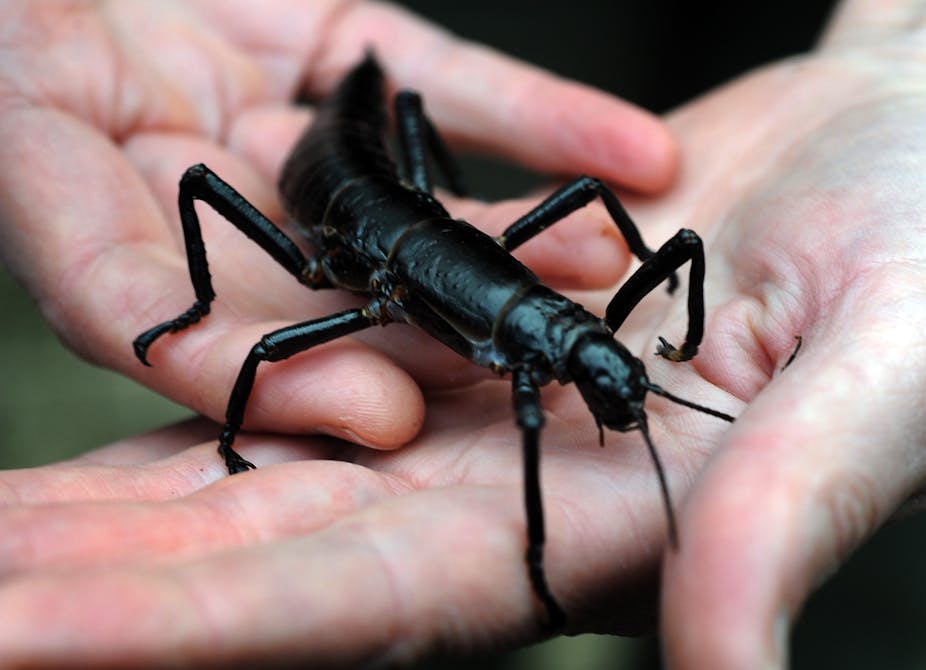The Lord Howe Island stick insect (Dryococelus australis) or “land lobster” is a large, flightless stick insect that was, until recently, thought to be extinct. It has a glossy brownish-black exoskeleton with some pale yellow markings where joints and body segments meet.
Females reach over 150 mm in length, while the slightly smaller males are characterised by strongly curved, spiny, muscular hind legs.
As the name suggests, this species was known only from Lord Howe Island, a small volcanic island situated in the Tasman Sea some 800 km north east of Sydney, Australia. It is nocturnal, feeding and moving around only at night, and sheltering in small tree hollows during the day. In 1916, Arthur Lea, a well-known Australian entomologist, visited the island and described seeing as many as 68 stick insects in a single tree hollow.
Status
The Lord Howe Island stick insect is arguably the rarest insect in the world. The species was abundant until sometime after 1918 when a vessel, the “Makembo”, ran aground nearby leading to the introduction of black rats (Rattus rattus) to Lord Howe Island. Within 30 years the stick insect was thought to be extinct due to predation.
In 1964 a group of climbers ventured onto the nearby island of Balls Pyramid. This steep, rocky outcrop is situated approximately 23km south east of Lord Howe Island and is virtually inaccessible. The adventurers made landfall and were able to take some photographs, including one of a recently dead Lord Howe Island stick insect.
No further exploration occurred until 2001 when a group of researchers returned to Balls Pyramid and rediscovered living adults. Today fewer than 30 adult stick insects remain on the Pyramid and the species is recognised as “Critically Endangered” by the IUCN Red List.
Threats

The greatest threat to the survival of the Lord Howe Island stick insect, and the cause of its extinction on the island, is the introduction of the black rat. Rat numbers have since been reduced but until rats are totally eradicated from Lord Howe Island the stick insect will remain vulnerable and cannot be reintroduced.
The tiny population on Balls Pyramid faces a number of different threats. This highly inaccessible island outcrop has very few areas of suitable habitat for the remaining population of stick insects. Only one species of food plant, Melaleuca howeana, grows on Balls Pyramid and it is at risk from environmental factors (such as drought, storms and rock falls), and an invasive vine (Morning Glory, Ipomoea cairica) that threatens to smother the few remaining plants. Poaching by private collectors of this highly-prized stick insect and its eggs is also of concern.
Strategy
The Critically Endangered population of stick insects remaining on Balls Pyramid is protected as part of the Lord Howe Permanent Park Preserve. Access to the Pyramid is carefully restricted and controlled by the Lord Howe Island Board.
Removal of the invasive Morning Glory vine from the small area occupied by the stick insects was successfully carried out in 2003. Interestingly, whole-scale removal of the vine from the Pyramid was discouraged as the vine is assisting with soil stabilisation on the steeper outcrops.
Most importantly, a breeding population of Lord Howe Island stick insects has been established at the Melbourne Zoo thus providing insurance against a second extinction event. It is hoped that individuals from the breeding population will eventually be reintroduced to Lord Howe Island, providing black rats can be successfully eradicated from the island.
Conclusion
Rediscovery of the Lord Howe Island stick insect on Balls Pyramid provides hope that other species thought to be extinct may persist elsewhere. However, it is highly unlikely that other extinct Lord Howe Island species will be found on nearby islands.
It is remarkable that the stick insect has been able to persist in such an inhospitable habitat and in such low numbers. However, like other species of stick insect the female Lord Howe Island stick insect is able to reproduce without the presence of males (a reproductive mode termed “parthenogenesis”). This means the population could be reduced to a single female stick insect and survive. However, this is not a desirable option. Protecting the remaining, vulnerable population of stick insects is still the best approach.
Read more: A personal experience of breeding Lord Howe Island stick insects.
The Conversation is running a series on Australian endangered species. See it here

